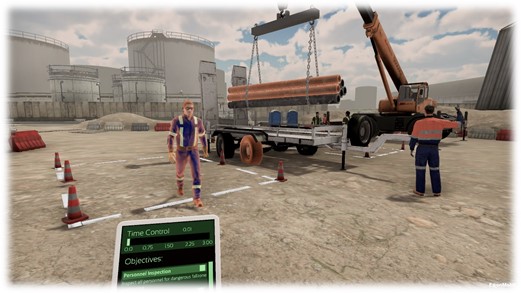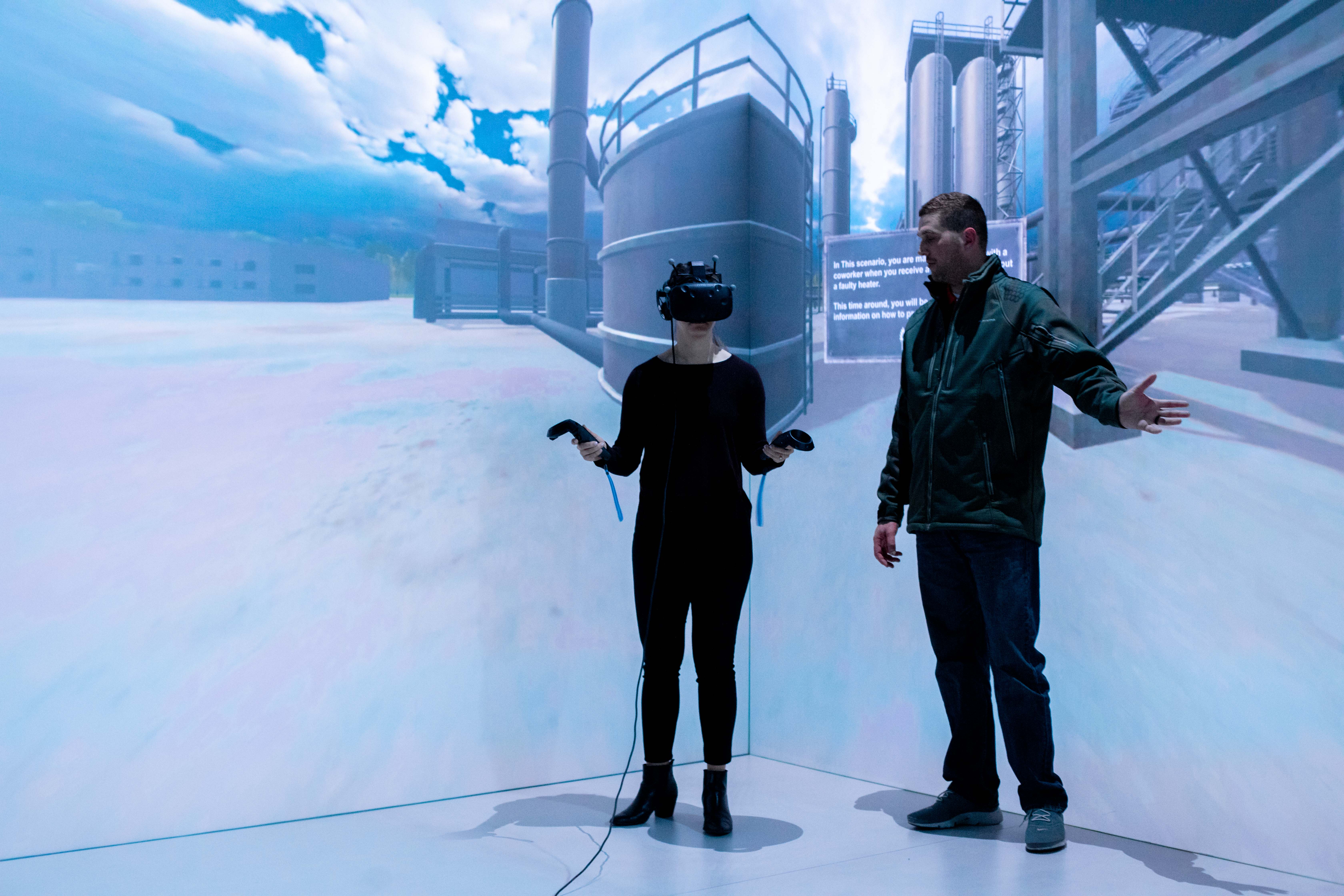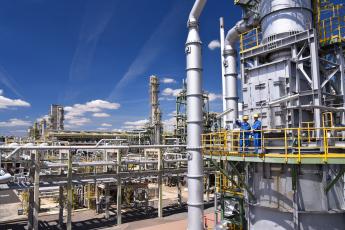The operator of an 800-ton crane at ExxonMobil’s Baton Rouge, Louisiana, polypropylene project construction site lowers a new 150-foot-tall reactor into place. The maneuver requires that he understands the physics of the lift, as well as ensuring the rigging is installed properly, the swing is stabilized and bystanders are safely out of the way.
Installing two reactors, with a combined weight of 1.1 million pounds, requires precision and a steady hand at the crane controls. That’s why the company is using virtual reality (VR) to train its crane operators before the heavy lifting begins. ExxonMobil is using VR training at the more than $500 million polypropylene project to improve work performance and safety, while also reducing training time.
“We’re hiring a lot of people, so it’s imperative we increase competency quickly — one way is through virtual reality,” says Keitt Wannamaker, project lead for the ExxonMobil polyolefins plant. “We have found that the VR training saves time, improves project reliability and, in some cases, is more cost-effective than traditional training methods.”

ExxonMobil is using virtual reality training at their polypropylene facility to improve safety, reduce training time, and help employees prepare for complex tasks.
VR allows workers to become familiar with the operations of the new plant before it’s completed, and ExxonMobil is hoping to expand the use of VR as it gears up for a major expansion of its facilities along the Gulf Coast.
Training the next generation
The safety performance at U.S. refineries and petrochemical facilities is better than ever and continues to improve, thanks in part to a range of technologies such as drones and systems that monitor facilities digitally instead of manually. Injury and incident rates at refineries and petrochemical facilities have dropped during the past 30 years and are now five-times lower than the total recordable rates of the entire manufacturing sector.
However, such good news also presents a new challenge: training a new generation of workers who have little first-hand experience with safety incidents. As their older colleagues retire, the transfer of institutional knowledge becomes more challenging without direct experience. Virtual and augmented reality can help meet this need.
Refiners and petrochemical manufacturers are among the advanced fields exploring the benefits of virtual reality training for employees. The health care and commercial aviation industries are also testing how VR can improve outcomes.
“Within the next 10 years, some companies will be losing 40 to 50 percent of their workforce,” said Christopher McAulay, an operations trainer with Sinclair’s refinery in Casper, Wyoming. “We have a bunch of people with three to six years of experience, and we want them to be ready if, for example, we’re putting something online they’ve never seen before.”
VR can help shorten the learning curve.
“As humans, our original way of learning is by contextually experiencing it,” says Tyler Gates, managing principal of Brightline Interactive, a VR development company that got its start nearly 16 years ago building training simulations for the U.S. Department of Defense. “We are spatial beings. VR helps people better understand what it is like to actually be in a certain real-life scenario — an experience that the brain remembers like a lived experience — operate in that environment, fail safely and learn from their decisions.”
Enhancing training with virtual reality
Since early 2019, Brightline has been working with the American Fuel & Petrochemical Manufacturers (AFPM) to develop a VR simulation that will supplement training for employees at refinery and petrochemical facilities. The complex, 130-task simulation will help ensure that employees are thoroughly trained in starting a fired heater, a key facility operation for which hands-on, in-the-field training is difficult due to the potential consequences of inaccurate execution. AFPM spearheaded the project to provide shared resources for its member companies, which comprise virtually all U.S. refining and petrochemical capacity.
The simulation being developed by the American Fuel & Petrochemical Manufacturers and developer Brightline will help workers train to start a fired heater, a key facility operation for which hands-on, in-the-field training is difficult. Above is a fly-through video of the virtual training environment.
“As AFPM develops these emerging training technologies and measures their effectiveness, our member representatives can take the results back to their companies, show the value of VR and potentially expand its use,” said Daniel Forest, manager of safety programs at AFPM.
The simulation begins in a classroom setting, which includes a tutorial that acclimates trainees to the VR environment, then covers the basics of key VR actions used in the simulation, such as the proper way to turn valves or press buttons. Trainees can choose between two learning scenarios: a guided simulation that walks the operator through the procedure, providing prompts and assistance; or an unguided module that allows the individual to fail safely and learn from their mistakes within the VR environment.
“When you look at millennials and Gen Z and look at how they learn, this VR and immersive learning component adds another style of learning, which this new workforce entering the market needs,” said Russell Klinegardner, chief operating officer of Houston Area Safety Council (HASC), which is also beginning to incorporate VR simulations into training for contractors for work at fuel and petrochemical facilities.
‘A more connected workforce’
In addition to programs such as those being developed by AFPM and HASC, refining and petrochemical companies are also studying technologies that connect workers and improve communications and collaboration.
For example, Flint Hills Resources is testing connected lens technology, which if adopted, would allow an engineer in Wichita to see exactly what his counterpart in Minnesota is doing and offer advice.
“We’re looking at different wearable devices to have a more connected workforce,” said Bjorn Olson, Flint Hills’ technical training lead.

An employee interacts with a digital refinery during a Flint Hills Resources training exercise. Training with virtual reality can lead to higher recall accuracy.
With connected lens technology, workers conducting highly complex tasks can consult experts in real-time regardless of location and distance. This bypasses the logistical challenges that once precluded experts from being on-site in situations where their experience is most needed.
U.S. refineries and petrochemical facilities are embracing these and other steady advances in virtual and augmented reality technologies to continue to improve safety, benefit employees and remain dynamic in the fast-paced energy marketplace.


